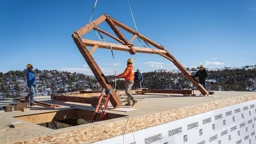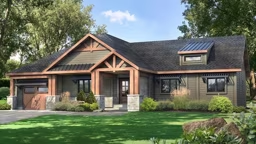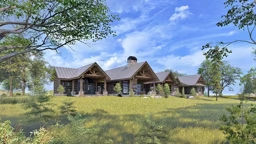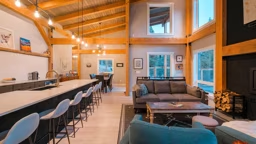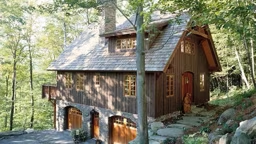
When you’re building a custom home, whether it’s built from logs, timbers, bricks or concrete, it’s common knowledge that you’ll have to manage costs. Yet this can be a big stumbling block for people. You know you have to do it, but how do you do it?
Imagine your budget as a bucket of money (it’s not an uncommon visualization, but it’s an effective one). Whether it’s a large bucket containing a million dollars or a smaller one with a few hundred thousand, there’s still a finite amount of money in it, and at various milestones in the project, your contractor will hand you sizable bills that you’ll have to pay from it. It’s essential to manage costs so that by the time you reach the end of the build, there’s still money enough to cover the final expenses.
The bucket is real … and it does have a bottom. Follow my building bucket list, and you’ll be able to efficiently manage your project’s costs from start to finish.
Bucket 1: The Log or Timber Package
Securing your log or timber home package will be one of the first and largest hits —as much as 35 percent — to the building budget. It also may be the most complicated. Typically, log and timber producers require a substantial deposit to start fabrication, with the balance due upon delivery.
Buyers often turn to bank financing, but a lender that’s inexperienced with the log and timber frame process may balk at that initial deposit. They’re used to paying for materials as they’re delivered to the site and can be inventoried. They need to understand that logs and timbers are custom cut to fit your home’s plan — not materials that can simply be restocked on a shelf if there’s a change — hence, the need for the upfront deposit.
So what can you do? Selecting a lender familiar with log and timber homes is an ideal option. If you can’t, understand what your bank is willing to fund upfront, and make sure you educate them on the unique draw schedules that occur in this type of building.
Self-funding, i.e., drawing from personal accounts, retirement funds, stock portfolios, etc., also may be an option, if you’re in a position to do it. Because you borrow against your own assets and pay yourself back instead of an outside entity there can be benefits, but there also may be tax implications.
Wherever the money is coming from, be sure you know your complete financial position, the requirements and what the associated ramifications and/or costs will be.
Bucket 2: Contractor’s Down Payment
On average, a contractor will charge 10 percent of the construction costs to secure his or her services. Let’s say your projected costs for the package, materials and labor comes to $500,000, then you can expect your contractor to request $50,000 up front to get the project started. Some contractors don’t charge an upfront fee, and this scenario can be advantageous because it allows you to keep more money in the contractor bucket for a longer period of time. The flip side is that you will need to pay him or her at a host of milestones for the duration, whereas contractors who charge the upfront fee typically don’t ask for progressive draws. (This can become open to conjecture; not only for you, but for the bank.) The exception may be if your home is very large and requires much more time to complete each stage than is typical.
During this stage, it’s important to understand not only what your costs are but what your equity position is. Relying on bank loans at this stage can be problematic, due to the bank’s perceived risk and the loan-to-value ratio, which may not be the total cost of the project. Having equity in your land will help, but you may want to consider withdrawing the deposit from a retirement fund (taking any tax or penalty implications into account).
Many future homeowners struggle at this stage of the process: You’re anywhere from 25 to 45 percent into your payments, and you don’t even have a hole in the ground yet … it’s all just paperwork! But rest assured that you are making progress toward the completion of your home, even if it doesn’t feel like it at the moment.
Bucket 3: Foundation and Site Work
Depending on where you’re building, your first “tangible” fees will be to prepare the site, and they will account for roughly 10 to 15 percent of your building budget. This includes creating an access road, grading the property, digging the foundation and bringing water and utilities to the property. Sometimes homebuyers will suggest using generators during construction to delay the cost of bringing power to the site. I advise against that because, in the end, it’s costing you more. Not only are you paying a higher price for generator- produced power, it’s an extra cost on top of the electrical lines you’ll have to bring to the property anyway.
Bucket 4: Log/Timber Delivery
It’s time for the log or timber package to arrive. This transportation cost will vary depending on the distance from your fabricator to the site, but as a rule, prepare to pay about 5 percent of your total. Your package and fee must be paid in full upon delivery.
It’s not uncommon to be more than halfway through your budget at this point — that’s a huge number when you consider that you still don’t have a house on the site. But rest assured that this is totally normal and necessary to move the project along.
Bucket 5: Erection, Framing & Construction Costs
Finally — there’s actual “building” happening! Your contractor and his or her team will erect the logs or timber frame on the foundation, then begin the process of drying it in; i.e., getting it under roof and installing windows and doors. On average (and this depends on the size and complexity of your home) this process takes about six weeks and uses 7 to 10 percent of your budget. Now, things will start to slow down a little bit.
Bucket 6: Rough-in Costs
This is your electrical wiring, plumbing and HVAC system installations, as well as things like whole-house vacuums, security systems and camera, Wi-Fi wiring, etc. Contractors and subs only get paid when the work they’ve done passes inspection, so once these are in place, the building inspector will review the work and, ideally, sign off on it. Expect this portion of the build to consume 5 to 10 percent of the total project.
Bucket 7: Fit & Finish
Depending on the type of home you have (full log, half-log hybrid, timber frame) drywall and other wall covering costs will vary. But every house will need cabinetry, countertops, plumbing and light fixtures, trim and millwork. Budget between 20 to 30 percent of your total spend, factoring in the quality level of the materials you plan to select.
Bucket 8: Final Grading/Landscaping
You’re almost there! All that’s left is the final grading of the property and landscaping. This shouldn’t require more than 3 to 5 percent.
When building a log or timber frame home, the thing that catches many people off-guard is the amount of money that’s needed to get the ball rolling, and the perception that “nothing is happening” for that money. Be assured that this is the normal mode of operations. The key is to understand this process and plan accordingly. With due diligence, the rest should fall into place.
Dan Mitchell is a log and timber home builder and educator, as well as president-elect of the Tennessee State Home Builders Association. He owns Eagle CDI, based near Knoxville.




